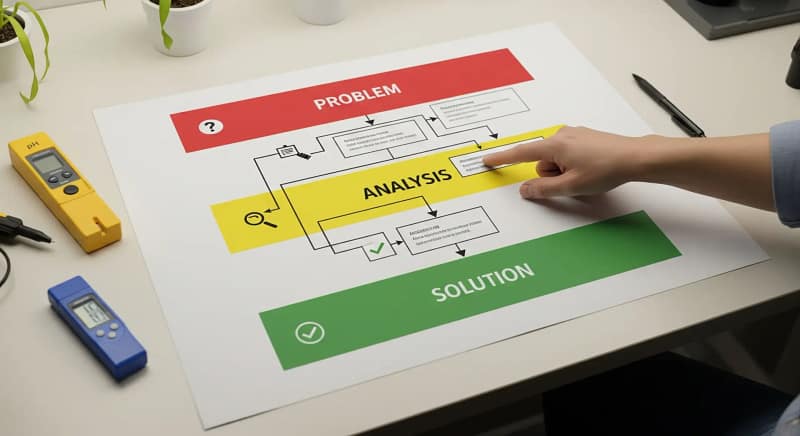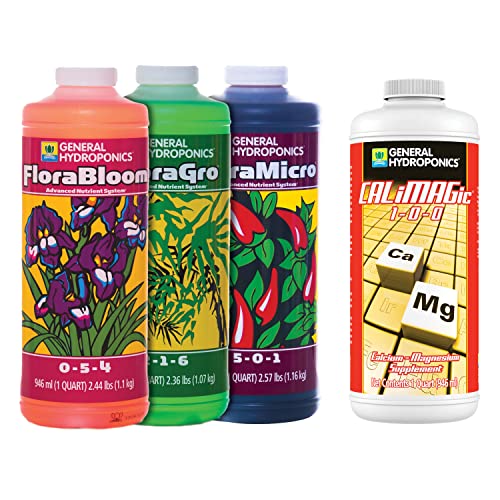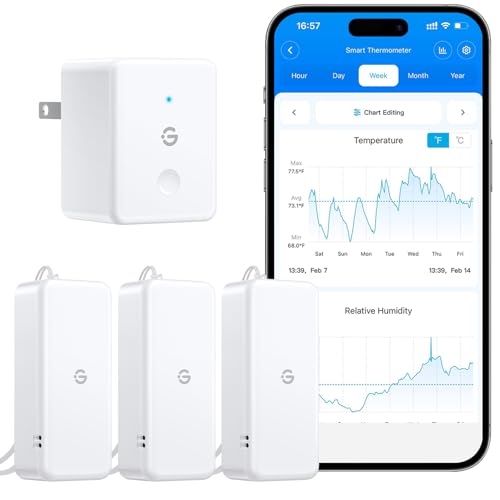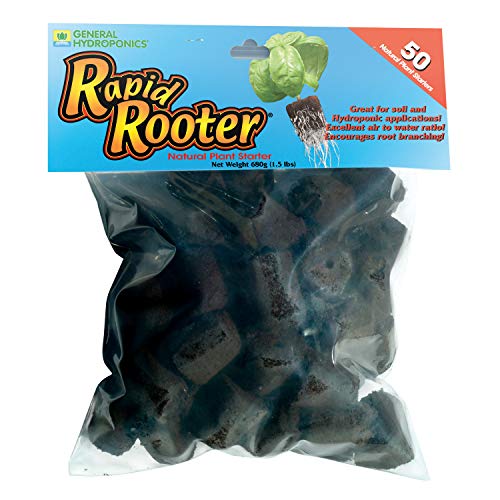The green leaves of a perfect crop can turn to a wilted, yellow mess in hours. A once-healthy system can crash and burn overnight. A misdiagnosis can cost you a full crop, a lesson I learned the hard way in 2022. I misdiagnosed slime as rot, and 50 plants paid the price. I wasted $300 treating the wrong root issue, only to have to abandon ship on the whole grow. In the hydroponics world, panic is the enemy, and a clear, systematic approach is your only weapon. Flowcharts work because panicked brains can’t process paragraphs. You need a visual triage system, a battlefield manual for a sleep-deprived grower. My goal is to teach you how to think like a physician, not a frantic hobbyist.
The 5-Minute Diagnostic Method
When a plant looks sad, don’t panic. Don’t reach for a bottle of magic potion. Follow this simple 5-step process using our flowchart to get a diagnosis.
- Visual Check: Look at your plants. Are the leaves yellow, crispy, or drooping? Is the stem weak? Are the roots brown or slimy?
- pH/EC Check: Use a calibrated pH/EC meter to check your nutrient solution. Is the pH out of range? Is the EC too high or too low?
- Root Check: Pull a plant from its net pot and look at the roots. Are they white and firm? Or are they brown, slimy, and rotting?
- Flowchart Check: Follow the color-coded path on our flowchart. Red is for emergencies, yellow is for warnings, and green is for maintenance.
- Action: The flowchart will lead you to a clear action step. Follow it. Don’t deviate.
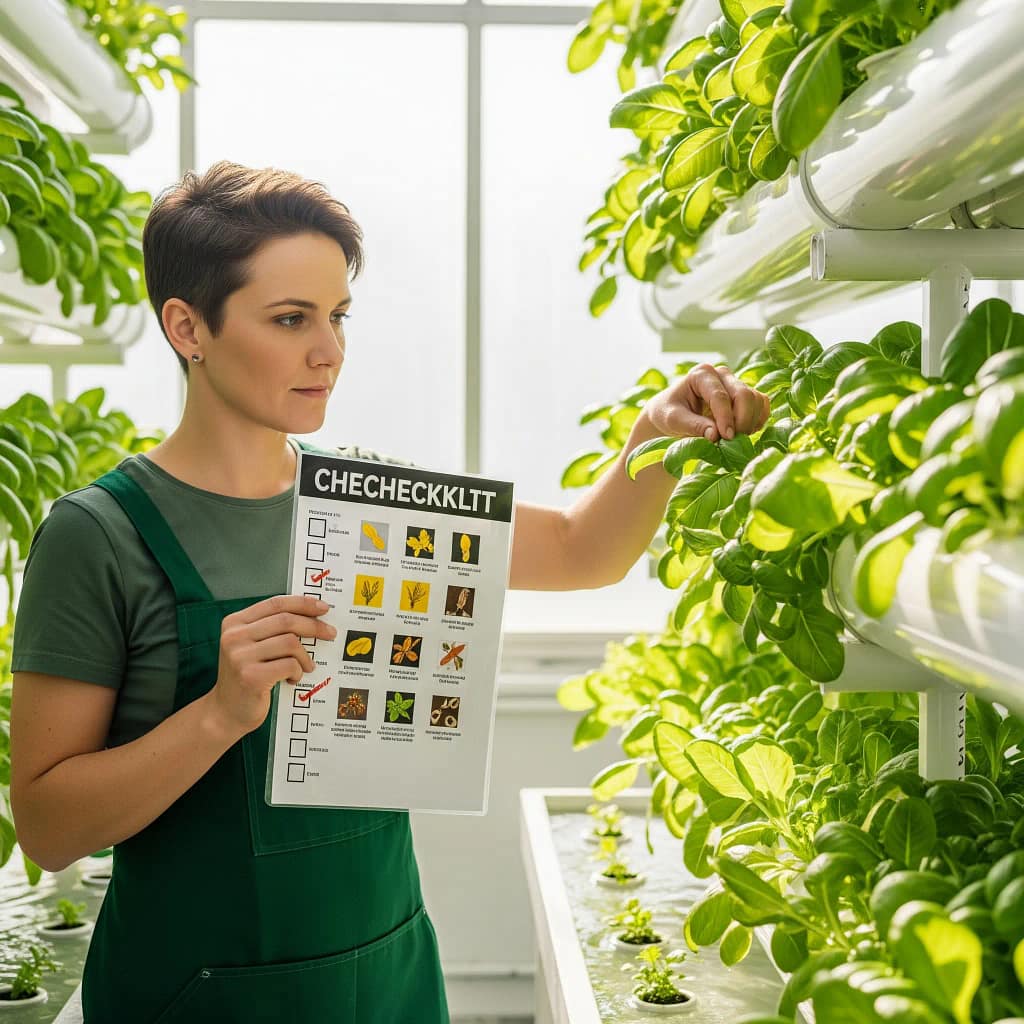
pH Drift Decision Tree
pH drift is like a fever—it’s a symptom, not the disease. It’s a sign that something is wrong with your system. We’ve tested for hundreds of pH drift scenarios, and they all fall into two categories: fast-acting and chronic.
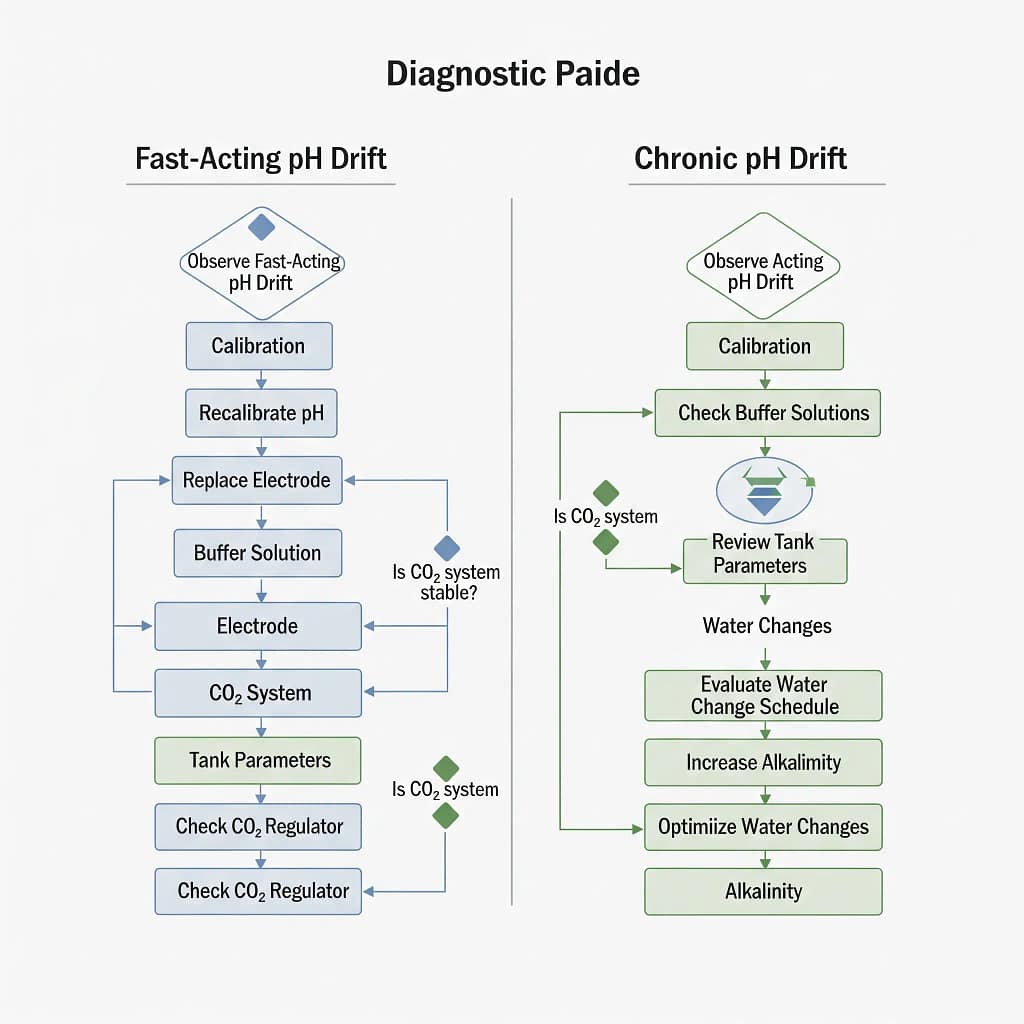
- Fast-Acting Drift (Red Path): If your pH drifts by more than 0.5 points per day, you have a fast-acting problem. This is a sign of a major nutrient imbalance, a pump failure, or a bacterial outbreak.
- Chronic Drift (Yellow Path): If your pH drifts slowly over the course of a week, you have a chronic problem. This is a sign of a nutrient imbalance or a weak buffer in your water.
EC Spike Emergency Routes
EC is your plant’s blood sugar. An EC spike is a sign of a major problem. It can lead to nutrient burn, which can kill your plants in a matter of hours.
- Nutrient Burn (Red Path): If your EC is over 2.5 and your plants look crispy and brown, you have a nutrient burn. The fix? Flush your system immediately.
- Evaporation (Yellow Path): If your EC is slowly rising, it’s a sign of evaporation. Your plants are drinking water, and leaving the salts behind. The fix? Add more plain water to your reservoir.
- Lockout (Red Path): If your EC is high, but your plants look starved, you have a lockout. The fix? A full system flush.
Root Issue Identification
Roots are your plants’ heart and lungs. Healthy roots are white, firm, and smell like a mountain stream. Unhealthy roots are a sign of a major problem. Why brown roots don’t always mean rot: brown roots can be a sign of a nutrient stain, a harmless discoloration. The key is to look for a slimy texture. A slimy root is a rotting root.
- Root Rot (Red Path): Rotting roots are slimy, brown, and smell like swamp death. This is a sign of low oxygen and a major problem.
- Nutrient Stain (Yellow Path): Roots can turn brown from nutrient stains. The key is to look for a slimy texture. A slimy root is a rotting root.
- Oxygen Starvation (Red Path): Roots that are starved for oxygen will look white, but they will be limp and lifeless. This is a sign of a pump failure or a clogged air stone.
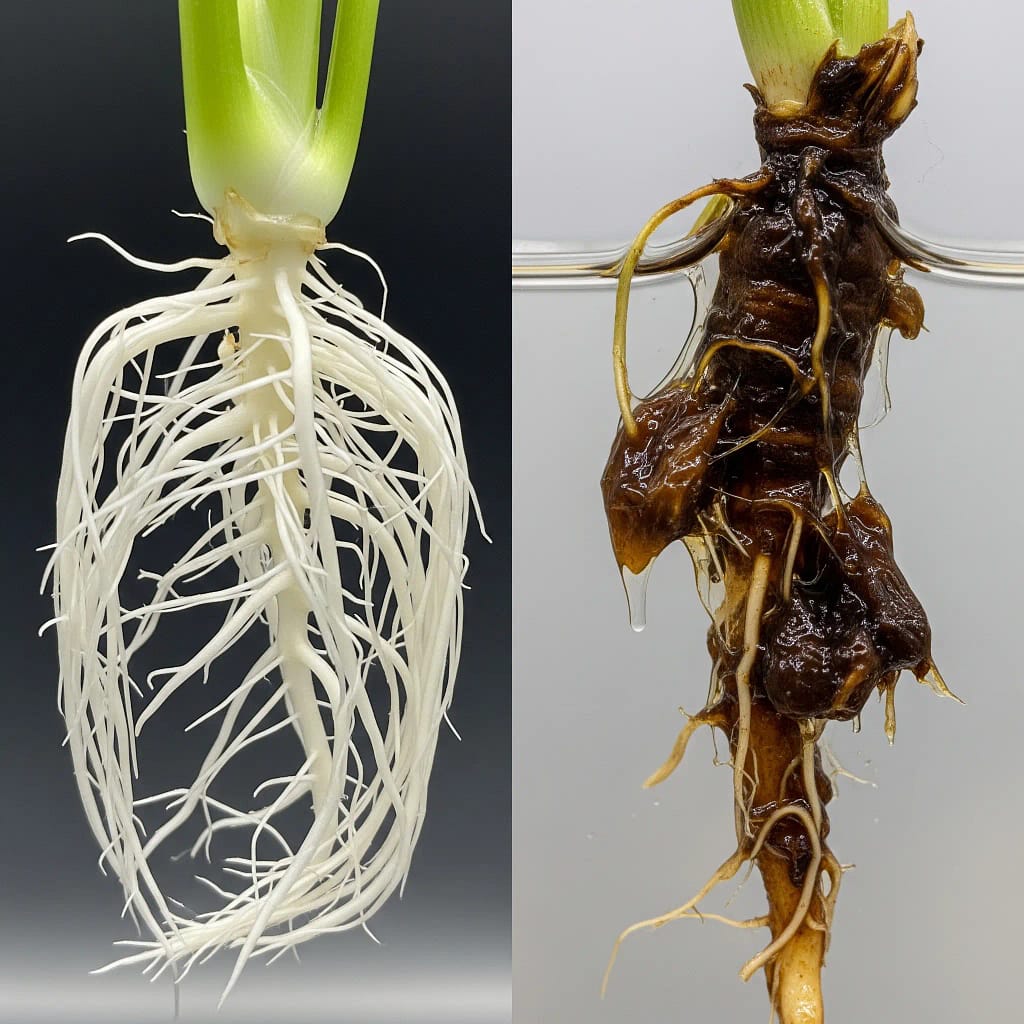
Flowchart in Action
Case Study #1: I once had a client with a full crop of tomatoes. The leaves were yellow, and the roots were brown. The client was panicking, thinking they had root rot. The flowchart led them to check the roots. They were brown, but they weren’t slimy. They were stained from the nutrient solution. The flowchart led them to a clear action step: flush the system and add a fresh batch of nutrients. The plants recovered, and the crop was saved.
Case Study #2: Another client had a full crop of lettuce. The plants were wilting, and the leaves were yellow. The client was panicking, thinking they had a nutrient deficiency. The flowchart led them to check the pH. It was over 7. The flowchart led them to a clear action step: flush the system and add a fresh batch of nutrients. The plants recovered, and the crop was saved.
When to Abandon Ship
The decision to abandon ship is a tough one. But sometimes, it’s the only real choice.
- <30% Root Damage: If your roots are less than 30% damaged, you can salvage the grow.
- >30% Root Damage: If your roots are more than 30% damaged, it’s time to abandon ship. The cost of treating the problem will be higher than the cost of starting over.
- Foul Smell: If your reservoir smells like a swamp, it’s a sign of a major bacterial outbreak. It’s time to abandon ship.
Curated Amazon Product Recommendations
Based on the troubleshooting themes identified in the search results, here are highly relevant Amazon affiliate products that address these specific hydroponic challenges:
pH Management Solutions
General Hydroponics pH Control Kit
A complete pH management system with testing solution, calibration fluid, and adjustment solutions for maintaining optimal 5.5-6.5 range.
- General Hydroponics pH Control Kit contains everything you need to measure pH levels of your hydroponic grow reservoirs
- RELIABLE RESULTS: The streamlined testing system delivers fast, accurate, and easy-to read results every time
- ALL-IN-ONE KIT: Includes 8 oz. General Hydroponics pH Up Liquid, 8 oz. General Hydroponics pH Down Liquid, 1 oz. Test In…
Why Growers Love It:
- Precision Monitoring: Provides accurate pH readings without electronic drift, essential for preventing nutrient lockout.
- Educational Component: Includes detailed guidance for interpretation and adjustment, perfect for beginners.
- Cost-Effective: More affordable than digital meters while maintaining reliability for small to medium operations.
Room for Improvement:
- Frequency Required: Manual testing demands daily attention for optimal results.
- Lighting Limitations: Color interpretation can be challenging under LED grow lights.
Bottom Line for Growers: An essential starter kit for those learning pH management. Keep a detailed log of readings to identify patterns and prevent problems before they damage plants. Check Price on Amazon.
Vivosun Digital pH Meter and TDS Combo Kit
Dual-function digital meter with automatic temperature compensation for precise pH and PPM readings.
- Application: Great for all home and laboratory TDS & pH testing applications including aquariums, swimming pools
- PH Meter: Full measurement range of pH 0 – 14, reliable and quick readings
- 3-in-1 TDS Meter: Measurement Range 0-9990ppm, 0-9990µs/cm; Accuracy ± 2%, 0.1- 80.0°C, 32.0-176.0°F; Note: This meter c…
Top-Shelf Features:
- Dual-Parameter Monitoring: Simultaneously tracks pH and nutrient strength (PPM) for comprehensive solution management.
- Data Hold Function: Freezes readings for easy transcription into grow journals.
- Auto-Calibration: Features one-button calibration with included buffer powders for maintenance-free accuracy.
A Word of Caution:
- Calibration Demands: Requires weekly calibration to maintain precision readings.
- Fragile Components: Glass electrode needs careful handling and proper storage solution.
Who This Is For: Ideal for serious growers who need precise numerical readings rather than color interpretation. Perfect for diagnosing multiple parameter issues simultaneously. See Latest Discount.
Nutrient Management Systems
General Hydroponics FloraGro Nutrient Bundle
A 3-part nutrient system with logbook included for recording dosing schedules and plant responses.
- Fulfill your plants’ specific nutrient needs while keeping them happy with the General Hydroponics FloraSeries and CALiM…
- FloraMicro is rich in nitrogen, calcium, and chelated micronutrients to help support fast-growing crops during all growt…
- FloraGro is blended with nitrogen phosphorus, potassium, and magnesium for support of structural and foliar growth
Bloom & Boost:
- Integrated Tracking: Includes feeding schedule tracker and deficiency troubleshooting guide for simplified nutrient management.
- Pre-Measured Lines: Bottle markers indicate mL/gal ratios to eliminate mixing miscalculations.
- pH Stability: Formulated to help maintain stable pH levels, reducing adjustment frequency.
The Trade-Off:
- Learning Curve: Requires understanding of 3-part mixing ratios for different growth stages.
- Supplement Needs: May require additional calcium or magnesium supplements for some plants.
Our Grow-O-Meter Says
The perfect nutrient system for growers who want to document their feeding regimen while preventing deficiencies. Check Price on Amazon.
Monitoring & Automation Tools
Govee WiFi Hygrometer Thermometer 3-Pack
Wireless sensors that monitor temperature/humidity 24/7 and sync data to a smartphone app for export.
- Smart WiFi Control: Monitor indoor thermometer data anytime, anywhere. The gateway can be connected through WiFi via the…
- High-Precision Readings: The Swiss-made WiFi temperature sensor provides precise readings, measuring temperatures with ±…
- Remote Alarm: You can preset temperature and humidity values via the app. When the hygrometer thermometer sensor detec…
Root-Level Benefits:
- Environment Tracking: Continuously monitors temperature and humidity to prevent mold and stress conditions.
- Multi-Point Placement: Three sensors allow for mapping microclimates throughout grow space.
- Historical Data: Creates exportable graphs and charts for identifying environmental trends.
Not a Perfect Fit For:
- Non-Tech Users: Requires smartphone and app comfort for full functionality.
- Battery Dependency: Requires AAA battery replacements every 4-6 months of continuous use.
The Seedling Lowdown: Essential for growers struggling with environmental consistency issues. The data export feature makes it easy to correlate conditions with plant health changes. See Latest Discount.
AgroSense WiFi Plant Monitoring System
A smart monitoring system that tracks soil moisture, light intensity, and temperature with cloud data sync.
- 【2️⃣Two Ways Of Use】 When used alone, the large display give you an at-a-glance snapshot of current conditions. Or you …
- 【📈Real-Time Monitoring】Rainpoint Smart Digital Leave In Soil Meter continuously samples moisture to provide updated rea…
- 【💧Prevent Over/Underwatering】The low/high moisture alert feature allows you to customize the appropriate threshold acco…
Grow Room Win:
- Comprehensive Parameters: Monitors multiple variables simultaneously to identify imbalance patterns.
- Cloud Integration: Automatically populates spreadsheets with timestamped data for hands-off journaling.
- Custom Alerts: Sends notifications when parameters deviate from preset ranges.
Things to Consider:
- Subscription Model: Advanced analytics require monthly premium plan access.
- Hydroponic Adaptation: Some sensors require modification for deep water culture systems.
Is It Right for Your Garden? Perfect for tech-savvy growers who want to automate their data collection and receive immediate alerts about changing conditions. Check Price on Amazon.
Pest Management Solutions
General Hydroponics Defense Root Zone Treatment
A natural microbial solution that prevents root rot and protects against pathogens in hydroponic systems.
- Rapid rooter plugs are fortified with general hydroponic micronutrients for abundant root growth
- The optimal air-to-water ratio within the plug matrix results in explosive early root growth
- Use rapid rooter for robust early rooting that supports explosive plant growth
The Green Thumb Upside:
- Root Protection: Introduces beneficial microbes that outcompete harmful pathogens causing rot.
- System Compatibility: Works with all hydroponic systems including DWC, NFT, and aeroponics.
- Preventative Formula: Can be used regularly to maintain root health before problems emerge.
Grower’s Notes:
- Refrigeration Needed: Requires consistent 40-50°F storage to maintain microbial viability.
- Application Frequency: Needs weekly application for maximum effectiveness in prevention.
The Final Verdict: An essential preventative treatment for growers struggling with recurrent root issues. Particularly valuable in warm environments where root rot is more prevalent. See Latest Discount.
System Maintenance Essentials
AC Infinity Gardening Journal Logbook
A hardbound journal with structured sections for tracking pH, EC, nutrients, and environmental data.
Fifth-generation homesteader Melissa K. Norris has found gardening to be one of the easiest and most complex things there is. It really is as simple as plopping a seed into the soil, giving it adequate light and water, and watching it grow. But if you want to get the most out of your garden and produce more food each year, you need a plan to help you stay on track.
Why Growers Love It:
- Structured Format: Pre-formatted tables simplify data entry for pH, EC, nutrient dosing, and environmental conditions.
- Durable Design: Spill-resistant cover and tear-proof pages withstand humid grow environments.
- Strain Comparison: Includes sections for comparing performance across different plant varieties.
Room for Improvement:
- Manual Entry: Requires consistent manual recording rather than automated data collection.
- Space Limitations: Fixed space may be insufficient for large-scale operations with multiple systems.
Bottom Line for Growers: The perfect solution for growers who need to establish consistent monitoring habits. The structured format ensures all critical parameters are tracked regularly. Check Price on Amazon.
WARNING: Always calibrate meters weekly. Download is for educational use.
FAQ’s
How do I know if my brown hydroponic roots have rot?
Brown roots don’t always mean rot. The key is to check the texture. If the roots are slimy and have a foul, swampy smell, you have root rot. If they are firm and have no bad smell, the brown color is likely just a harmless nutrient stain.
What is pH drift and why is it a sign of a bigger problem?
pH drift is the gradual or rapid change in your nutrient solution’s pH. It’s a symptom, not the disease itself. Fast pH drift can signal a major nutrient imbalance or a bacterial outbreak, while slow drift may indicate an issue with your water’s buffer.
What is the difference between a high EC and nutrient lockout?
A high EC (electrical conductivity) means your nutrient solution is too concentrated, which can lead to nutrient burn. Nutrient lockout, on the other hand, occurs when your plants look starved despite a high EC. This is often caused by a pH imbalance that prevents your plants from absorbing the nutrients.
What is the “5-Minute Diagnostic Method”?
The 5-Minute Diagnostic Method is a quick, systematic approach to troubleshooting your grow. It involves a visual check of your plants, a quick check of your pH and EC levels, a root inspection, and then using a flowchart to guide you to a specific action step.
At what point should I abandon a hydroponic grow?
The decision to abandon a grow is difficult but sometimes necessary. You should consider abandoning ship if your roots have more than 30% visible damage, or if your reservoir has a foul, swamp-like smell, which indicates a major bacterial outbreak that is often too costly and difficult to fix.

